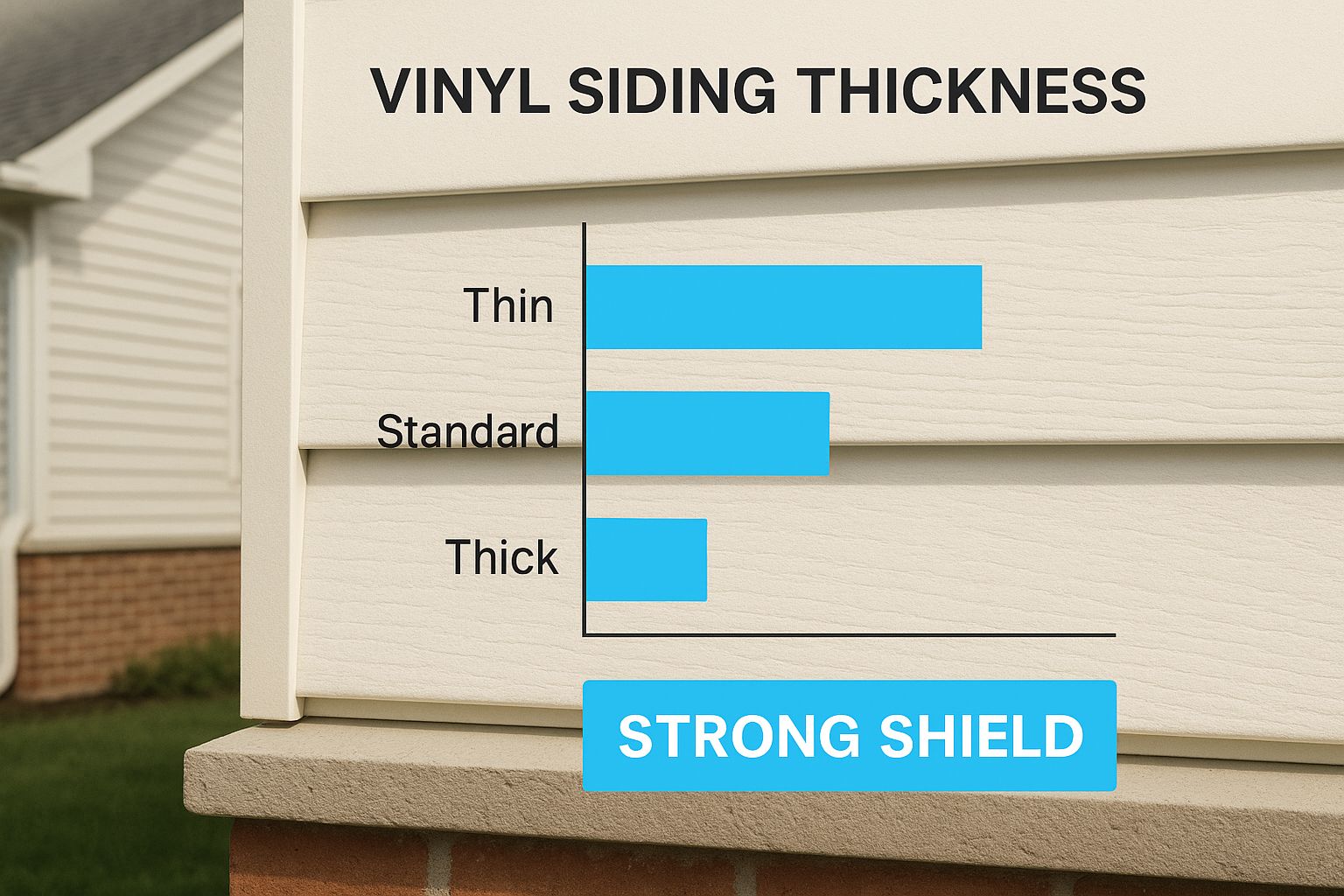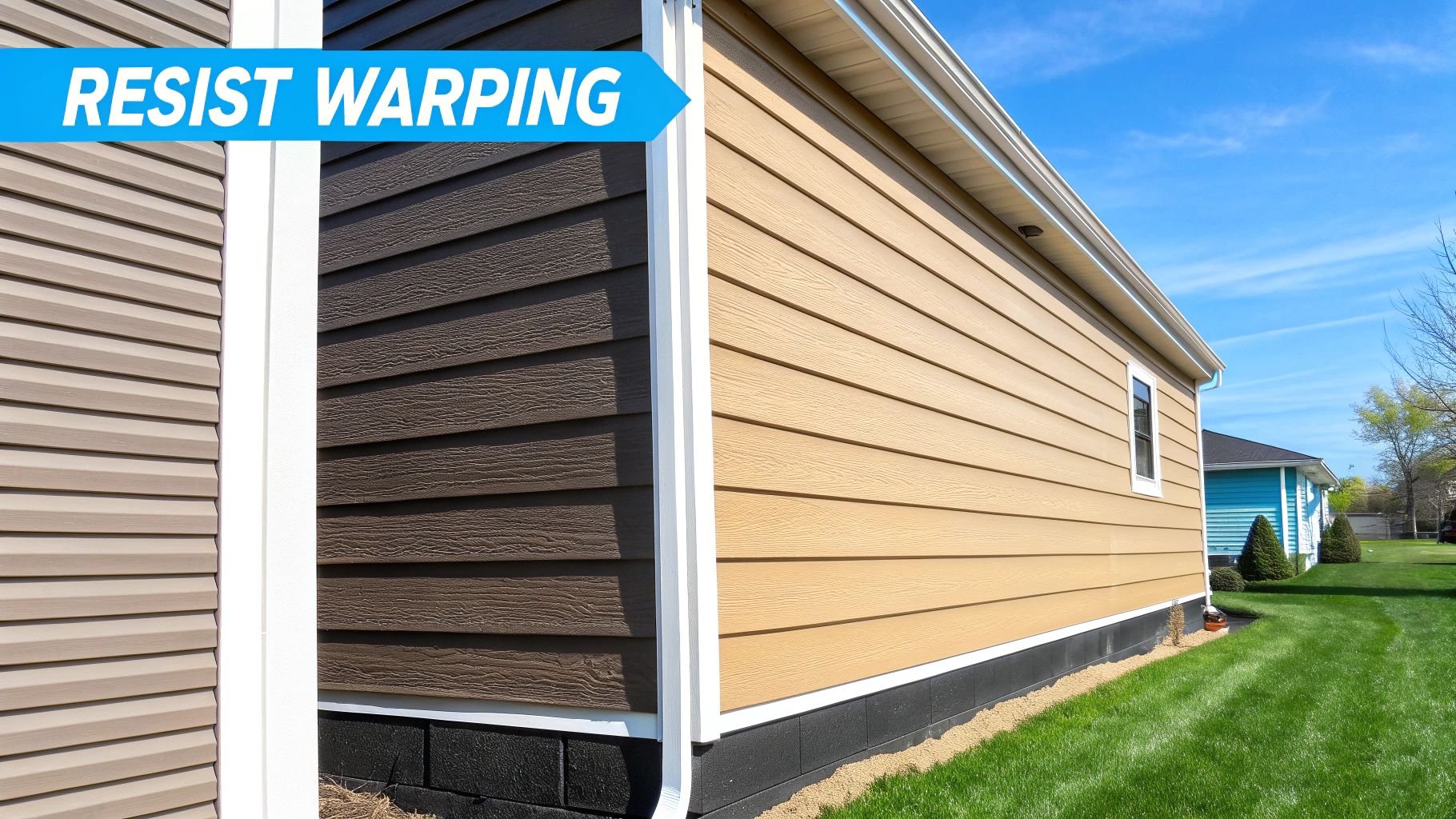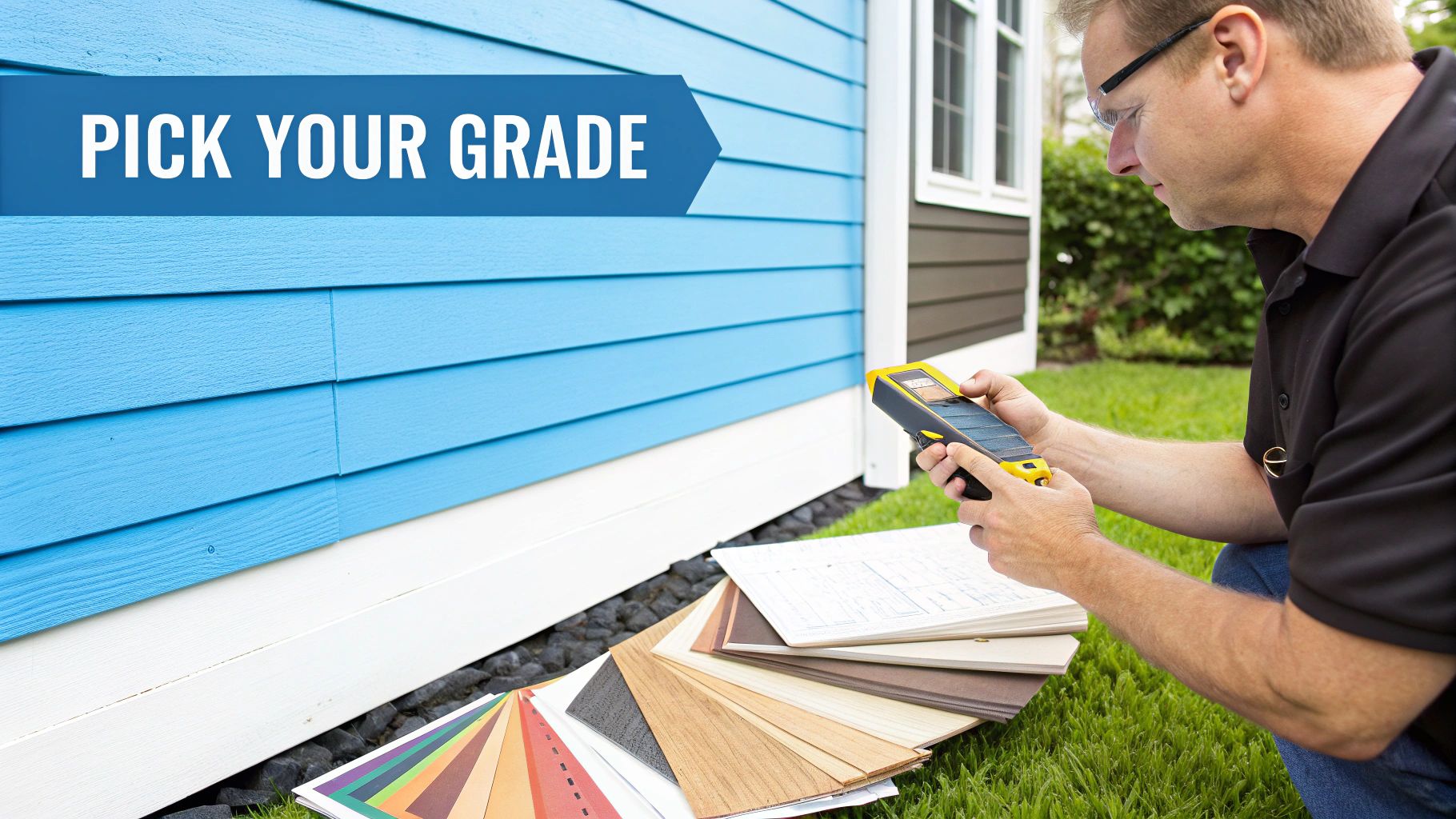When you’re choosing new siding, the thickness of the panels is one of the most critical decisions you'll make. It’s the difference between siding that looks good for a few years and siding that protects your home and stays beautiful for decades. A thicker panel simply holds up better against impacts and maintains the crisp, straight lines that keep your home looking sharp.
This isn't a minor detail to gloss over; it's a foundational choice that dictates the success and longevity of your siding replacement project.
Why Vinyl Siding Thickness Is So Important
A great analogy is buying a new phone case. You could get a super-thin, flimsy one that offers basic scratch protection, or you could get a more substantial case that can actually handle a real drop. Vinyl siding thickness works the same way—it's the protective armor for your home, especially in a place with weather as unpredictable as the Pacific Northwest.
Not all vinyl siding is created equal, and those tiny measurements make a world of difference. A thicker panel has more structural integrity, meaning it’s far less likely to sag, warp, or bow when exposed to the sun or seasonal temperature swings. It’s also much better at shrugging off everyday dings and dents from hail, stray soccer balls, or a run-in with the lawnmower.
Thicker siding is an investment in your home's long-term health and value. You’ll spend less time and money on repairs down the road, and your curb appeal will hold up for years longer than it would with a basic, economy-grade panel.
This infographic gives a great visual of how a thicker panel acts as a stronger shield for your home.

As you can see, a more substantial panel creates a tougher barrier, keeping your home better protected. Getting familiar with the common industry gauges is the first step in understanding how a fraction of an inch can completely change the way your siding performs.
Understanding Siding Gauges and Grades
When you start shopping for vinyl siding, you'll hear a lot about its "gauge" or thickness. It might sound like technical jargon, but it's one of the most important factors in how your siding will look and perform for years to come. Simply put, thicker siding is stronger, hangs straighter, and is more resistant to whatever the weather throws at it.
The industry breaks down vinyl siding into a few common grades based on its thickness. Let's look at what those numbers actually mean for your home.
Decoding the Three Tiers of Siding
The thinnest option you'll find is Builder's Grade, which usually measures between .040" and .042". It's the go-to for projects where the bottom line is the absolute top priority—think sheds, detached garages, or rental properties. A trade secret is that its flexibility can actually telegraph imperfections in the wall underneath, showing every little bump and wave.
Most homeowners land on Residential Premium, which measures .044" to .046". This is the sweet spot for a reason. It offers a major step up in rigidity, which helps it hang straighter, resist warping from sun exposure, and hide minor wall imperfections. This grade delivers a much cleaner, more uniform look and is a smart investment for long-term value.
At the top of the line is Super Premium siding, which starts at .048" and can go even thicker. This is the heavyweight of the bunch, built for maximum durability and impact resistance. If you want the straightest lines and ultimate peace of mind, this is it.
In the Pacific Northwest, we almost always advise homeowners to start at the Residential Premium grade. Anything less is a compromise that just doesn't make sense with our climate's constant rain, wind, and temperature swings. You need a panel that won't get brittle or sag over time.
This shift toward more robust materials isn't just a local trend. While standard thickness siding still makes up a big slice of the market, homeowners in areas with tough weather are increasingly opting for heavy-duty panels. They're realizing the value in siding that can stand up to high winds and hail. You can read more about these market trends and see what's popular across the country.
To help you visualize the differences, we've put together a simple guide.
Vinyl Siding Thickness Comparison Guide
This table breaks down the key performance differences between common vinyl siding thickness grades, helping homeowners choose the best option for their budget and climate.
| Thickness Grade | Gauge (Inches) | Best For | Durability & Impact Resistance | Cost Index |
|---|---|---|---|---|
| Builder's Grade | .040" – .042" | Sheds, rental properties, tight budgets | Low | $ |
| Residential Premium | .044" – .046" | Most homes, balanced value and performance | Medium-High | $$ |
| Super Premium | .048" + | High-end homes, harsh climates, maximum longevity | High | $$$ |
In the end, choosing the right thickness is all about finding that perfect balance between your budget, your home's needs, and the demands of our beautiful (and often challenging) Pacific Northwest environment.
How Thickness Affects Durability and Weathering
It can be tough to connect a number on a spec sheet to how your siding will actually hold up against Mother Nature, but it’s one of the most important things to understand. The structural rigidity that comes with a thicker vinyl panel is your home's best defense against common headaches like sagging, bowing, and even warping from intense summer sun.
Think of it like comparing a flimsy sheet of paper to a sturdy piece of cardstock. The paper gives way at the slightest pressure, while the cardstock maintains its form. It's the same principle with siding; a thicker profile provides the backbone needed to keep your home's exterior looking straight and clean for decades.
By investing in a thicker profile, you're not just buying siding; you're buying peace of mind. This choice is a long-term investment in your home's structural integrity and curb appeal, which ultimately reduces the likelihood of costly future repairs.
This focus on durability is part of a bigger evolution in building standards. In the early days, vinyl siding was a lot thinner than what you see on most quality homes today.

Built For Pacific Northwest Weather
Here in the Pacific Northwest, we know a thing or two about wind. Those big storms that roll through can make thinner panels rattle, flex, or even pull away from the wall. Thicker vinyl siding, on the other hand, offers far better resistance to these forces, staying put and keeping your home protected. You can see how a professional installation secures these panels in our siding project gallery.
Siding material quality has improved dramatically over the years to meet these demands. Back in the 1980s, an average panel was only about .035 to .040 inches thick. Fast forward to the 2000s, and the .046-inch heavy-duty thickness became the go-to standard for builders who wanted to deliver a higher-quality product, especially in places with rough weather. You can discover more insights about vinyl siding market trends to see how the industry has shifted.
This increased vinyl siding thickness also means much better impact resistance. For your home, that translates to real-world protection from:
- Hail Damage: Thicker panels are much less likely to crack or get punctured during a hailstorm.
- Debris: They stand up better to impacts from windblown branches and other storm debris.
- Everyday Life: Let's be real—accidental bumps from the lawnmower or a stray baseball are less likely to leave a dent.
Opting for a more substantial panel is just a smart way to ensure your home is ready for the unique challenges of our local climate, safeguarding your investment from day one.
The Added Benefits of Insulated Vinyl Siding
If standard vinyl siding is a good coat for your home, think of insulated vinyl siding as a high-performance winter jacket. This isn't just a thicker panel; it's an engineered system. A rigid foam backing is permanently bonded directly to the vinyl, creating a single, solid piece that offers a huge leap in performance.
For homeowners in the Pacific Northwest, this integrated foam backing solves two big problems. First, it makes the siding incredibly tough. The foam acts like a shock absorber, so stray baseballs, hail, or an accidental bump from the lawnmower are far less likely to cause dents or cracks.
Second, it wraps your home in a seamless blanket of insulation. This is a game-changer because it helps block "thermal bridging," where heat escapes through the wooden studs in your walls—a major source of energy loss.
Creating a More Efficient Home
By adding that continuous layer of foam, insulated siding creates a thermal break that dramatically slows down heat transfer. This means you’ll likely see a real difference in your heating and cooling bills, keeping your home cozier in the winter and cooler in the summer.
As a bonus, that dense foam is also fantastic at dampening outside noise. If you live on a busy street, you'll appreciate the quieter, more peaceful atmosphere inside.
Insulated vinyl siding transforms the exterior of your home from a simple shell into a high-performance envelope. It's an investment in durability, energy efficiency, and overall comfort that pays dividends for years.
The combination of the vinyl and foam backing results in a panel that's often thicker than 0.050 inches. More importantly, some studies suggest this design can boost a home's overall energy efficiency by 10-20%. You can find more insulated siding performance data to see how it adds up.
How to Pick the Right Siding Thickness for Your Home
When it comes to picking the right vinyl siding, the final decision really boils down to balancing durability, your budget, and what your home actually needs. It’s not just about picking the thickest option. Thinking through a few key factors will help you land on the perfect panel that protects your home and looks great for decades.

Key Factors to Guide Your Choice
First, you have to think about our local weather. Here in the Pacific Northwest, we get our fair share of gusty winds and temperature swings from one season to the next. A thicker siding panel, something .046" or more, is just built tougher. It’s more stable, so it won’t flex and rattle in a storm or warp when the temperature spikes.
Next, take a good, hard look at your home's exterior walls. If you have an older house, chances are the walls aren't perfectly flat—they might have some subtle waves or bumps. A more rigid, thicker siding panel does a fantastic job of hiding those imperfections, giving you a smooth, crisp finish that seriously boosts your curb appeal.
For most homeowners around here, a .044"–.046" Residential Premium panel hits the sweet spot. You get the robust performance needed to handle our climate without jumping up to the premium price of the thickest specialty options.
Finally, it's all about weighing the upfront cost against the long-term value.
Your Budget: Thicker siding does cost more initially, but it often pays for itself over the years. Because it's more durable, you'll spend less time and money on upkeep, and it will simply last longer. It’s one of those investments that makes solid financial sense down the road.
Home Value: It's also smart to match your siding quality to the overall value of your home and neighborhood. Quality siding doesn't just protect your investment; it enhances it. It can make a real difference in your home's market value if you ever decide to sell.
By thinking through these four points—our climate, your wall condition, your budget, and your home’s value—you can make a choice that goes beyond just the numbers on a spec sheet. You’ll be able to confidently pick a siding thickness that gives you the perfect combination of strength, beauty, and performance for years to come.
Siding Thickness: Your Questions Answered
Picking the right vinyl siding can feel like you're drowning in numbers and specs. Let's clear up some of the most common questions homeowners ask about siding thickness so you can feel good about your choice.
Is Thicker Vinyl Siding Really Worth the Extra Money?
For your home, especially here in the Pacific Northwest, the answer is almost always yes. While that super-thin builder's grade siding might be fine for a backyard shed, investing a bit more in a premium residential grade (think .044" to .046") pays off big time.
That small jump in price gets you a huge leap in performance. We're talking about siding that stands up to summer heat without warping, resists cracking in a cold snap, and won't dent as easily from a stray baseball or hail. Over the life of your home, that durability means fewer repairs and a longer-lasting, beautiful exterior.
You're not just buying a thicker piece of plastic. You're investing in peace of mind and a tougher shield for your home that will hold up against our wild weather year after year.
Can I Just Eyeball the Thickness on a House?
From the street? Not a chance. Once it's up on the wall, telling the difference between a .042" panel and a .046" panel is practically impossible for even a trained eye. The visual difference is just too small.
Where you'll notice it is in your hands. A best practice is to ask your contractor to bring physical samples. A thicker panel feels solid and rigid, while the thinner stuff will feel flimsy and flexible by comparison. It’s an immediate, tangible difference.
To make sure you get exactly what you're paying for, get the product specs in writing. The vinyl siding thickness is always printed right on the box, so there’s no guesswork involved.
Does a Thicker Siding Limit My Color Choices?
Usually, no. Most brands offer their entire standard color palette across all their different siding grades. You won't have to sacrifice your favorite color just to get a more durable panel.
But here's a pro-tip: the thickest, most durable siding is often part of a manufacturer's top-of-the-line collection. These premium lines sometimes come with exclusive, richer color options and more advanced UV-resistant finishes you can't get on the thinner grades. So, by choosing a thicker product, you might actually open the door to more high-end styles.
Ready to wrap your home in siding that can handle the Pacific Northwest climate? The pros at Breeze Siding are here to help you navigate the options and find the perfect fit. Contact us today for a free, no-obligation estimate and see what a professional installation can do for your home.

